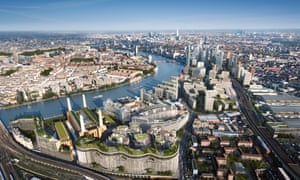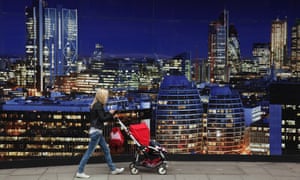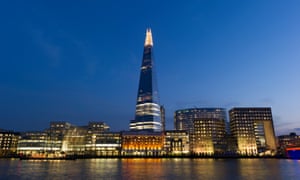Developers have 420 towers in pipeline despite up to 15,000 high-end flats still on the market
More than half of the 1,900 ultra-luxury apartments built in London last year failed to sell, raising fears that the capital will be left with dozens of “posh ghost towers”.
The swanky flats, complete with private gyms, swimming pools and cinema rooms, are lying empty as hundreds of thousands of would-be first-time buyers struggle to find an affordable home.
The total number of unsold luxury new-build homes, which are rarely advertised at less than £1m, has now hit a record high of 3,000 units, as the rich overseas investors they were built for turn their backs on the UK due to Brexit uncertainty and the hike in stamp duty on second homes.
Builders started work last year on 1,900 apartments priced at more than £1,500 per sq ft, but only 900 have sold, according to property data experts Molior London. A typical high-end three-bedroom apartment consists of around 2,000 sq ft, which works out at a sale price of £3m.
There are an extra 14,000 unsold apartments on the market for between £1,000-£1,500 per sq ft. The average price per sq ft across the UK is £211.
Molior says it would take at least three years to sell the glut of ultra-luxury flats if sales continue at their current rate and if no further new-builds are started.
However, ambitious property developers have a further 420 residential towers (each at least 20 storeys high) in the pipeline, says New London Architecture and GL Hearn.
Henry Pryor, a property buying agent, says the London luxury new-build market is “already overstuffed but we’re just building more of them”.
“We’re going to have loads of empty and part-built posh ghost towers,” he says. “They were built as gambling chips for rich overseas investors, but they are no longer interested in the London casino and have moved on.”
Pryor says developers of luxury blocks lining the Thames have failed to sell homes despite offering discounts, incentives and freebies – including free furniture, carpets and curtains and even cars. He adds that new-build towers are proving hard to sell because while they offer luxuries including concierge, gyms and spas, “they’re all the same”.
Some developers have delayed construction of projects, while others have taken properties off the market. All 10 of the apartments at the top of the Shard – priced at up to £50m each – remain unsold more than five years after the Duke of York and the former prime minister of Qatar officially opened “Europe’s first vertical city”.
Steven Herd, founder and chief executive of MyLondonHome, an agency that specialises in new-build homes for investment, says his firm is struggling under the weight of overseas investors who bought in the last couple of years and are desperate to sell.
He says hundreds of Asian investors who had bought London developments off-plan in 2015-16 in the hope of making a quick profit by selling apartments on closer to completion have instead lost hundreds of thousands of pounds. “They intended to flip [buy and sell on] the apartments and make big profits, but it hasn’t worked out like that, and now they are trying to get out at the smallest possible loss.”
He adds that in one case a Russian investor bought an off-plan property in 2014 for £3.1m, but couldn’t afford to complete and sold it for £2.55m.
Herd says the Nine Elms development, near the new US embassy in south London, was one of the best redevelopment schemes in Europe but consisted of “the wrong properties that Londoners don’t need”.
“We need ‘affordable’ one- or two-bedroom apartments priced at £500,000. We don’t need swimming pools and empty rooftop bars with no one living at home to buy drinks at them. There’s just way too many £1.5m-£2m-£3m flats that all look the same.
“We’d be much better off with decent quality but lower-spec homes built for actual Londoners. What’s the point in having private cinema rooms that sit empty and resident’s swimming pools with no one swimming in them; it just seems wrong.”
In its report, based on interviews with 684 developers across London, Molior says sales of new homes in London fell by a fifth over the last three months of 2017 compared with the previous quarter. “New starts on site also fell by a fifth, but starts still out-paced sales … so the number of unsold units continues to grow.”
The report says many developers face a “gloomy picture of falling sales” and are “perhaps starting to become uncomfortable with the emerging situation”.
Molior says some inexperienced developers who hoped to cash-in on demand from overseas investors now find themselves “off-pitch in terms of the location/quality/price equation”.
“Experienced players are increasingly rumoured to be resorting to ‘Plan-B’, while the fate of newcomers may depend on whether they can afford to sit-it-out or rent-it-out,” Molior says. The consultancy adds that “plan B” would typically involve a “bulk sale”.
Hoping for great profits, developers have continued to build expensive towers, while the greatest demand from Londoners is for more affordable homes. Estate agent Savills estimates that 58% of demand in London is for homes priced below £450 psf, but only 25% of homes being built are at this price.
Marcus Dixon, head of research at property data service LonRes, says the very peak of the London prime property market was still selling well but it was proving difficult to sell expensive and well-appointed apartments in big towers.
“Lots of schemes started two to three years ago and are now coming to market,” he says. “It’s the big towers with lots and lots of units in them [that are proving hard to sell]. Those in Nine Elms [near Battersea power station] and Earls Court which in the less distant past would have been sold off-plan to overseas investors. But the buyers, for various reasons including Brexit, just aren’t there any more for those sort of properties.
“The volumes that are coming out of the ground in Nine Elms are huge, and it’s a lot of flats that are all quite similar in terms of spec and price.”
Dixon says he expected developers to “go slow” or halt the later stages of developments until they have managed to sell more of the stock they’ve already built. But he adds that slowing production of flats was a lot harder than building traditional houses. “If you’re building an estate of 100 houses in the countryside, you can stop building when they’re not selling,” he says. “But if you’re building a big tower you can’t have anyone living in them until the whole tower is completed.”
He adds that that if a homeowner can’t sell their home at the price they’re aiming for they can withdraw it from the market but “for developer’s that’s not a solution – developers in some ways are forced sellers”.
Dixon says developers are switching their marketing efforts from overseas to local owner occupiers, “but they compare the price of new-builds to the secondhand market and find that there’s a high premium on new-build towers”.



No comments:
Post a Comment